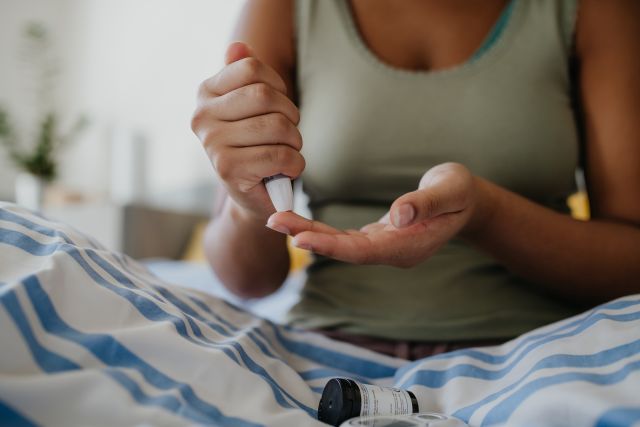Updated on January 19, 2022.
Have you ever had a mood swing or felt shaky between meals? It might have been the result of hypoglycemia.
Hypoglycemia, or low blood sugar, is common among people with diabetes. People with diabetes often take insulin and other medications to regulate their blood sugar levels, but sometimes blood sugar can drop or spike to unhealthy levels.
Hypoglycemia is easily treated in its early stages. But if left untreated, it can cause serious complications like seizures or a diabetic coma. If you have diabetes, it’s important to check your blood sugar often, travel with the proper snacks and supplies, and consult your diabetes action plan to help treat hypoglycemia as soon as it crops up.
What counts as low blood sugar?
For most people with diabetes, “low” means a blood sugar level of less than 70 milligrams per deciliter (mg/dL). Hypoglycemia is considered severe—and a potential emergency—when your blood sugar drops below 54 mg/dL.
The safe range can vary from person to person, which makes it important to discuss hypoglycemia with your diabetes specialist. They can explain which numbers are too low for you and help you make a hypoglycemia action plan. This should include all the steps that you, or those around you, need to take if you experience hypoglycemia.
What are the symptoms of hypoglycemia?
The symptoms of hypoglycemia are often mild at first. Typically, a fast-acting carbohydrate like glucose tablets or sugar cubes can offer quick relief. You should carry an appropriate snack at all times and check your blood sugar if you experience any of the following:
- Hunger or shakiness
- Sweating
- Paleness
- Fast heartbeat
- Exhaustion
- Confusion or trouble concentrating
- Irritability
- Sweating through your pajamas, crying out or having nightmares during sleep; waking up annoyed or confused
If hypoglycemia goes untreated, it can cause serious problems, including:
- Trouble walking
- Vision changes
- Fainting
- Seizures
- Injuries to yourself or others (for example, if you faint while driving)
Some people don’t experience any symptoms until hypoglycemia becomes an emergency. This is called hypoglycemia unawareness. If you’re prone to this condition, you should:
- Check your blood sugar frequently
- Check it before driving
- Consider wearing a medical alert bracelet
- Consider using a continuous glucose monitor, especially one which will issue an alarm in case of low blood sugar levels
In its most advanced stage, hypoglycemia can lead to coma or death. Protect yourself by including family and friends in your diabetes action plan. They should know which symptoms to look for and what to do if you cannot speak for yourself.
How is hypoglycemia treated?
Check your blood sugar right away if you feel any hypoglycemia symptoms. It may also be appropriate to check it before eating, sleeping, and exercising.
If it’s 70 mg/dL or lower, eat a snack that contains glucose or a fast-acting carbohydrate. Scan nutrition labels for items with about 15 grams of carbohydrates. Examples include:
- Four glucose tablets
- One tube of glucose gel
- A tablespoon of honey or sugar
- Two tablespoons of raisins
- A half cup of regular soda or fruit juice
Note: If you have kidney disease, avoid orange juice. It may contain too much potassium for you.
Check your blood sugar 15 minutes after you snack. If it’s still below 70 mg/dL, take another fast-acting carb. Check your blood sugar again 15 minutes after that. Repeat the process until it returns to normal.
Once your blood sugar is stable, eat a balanced meal or snack to keep it from crashing again. This can include fatty foods like chocolate and high-protein foods like peanut butter. (Skip these foods during hypoglycemia episodes because they can slow your blood sugar’s rise.)
If it will be more than an hour before you have a chance to eat a meal, have another snack consisting of 15 grams of carbohydrate and 1 ounce of protein, such as a few crackers with cheese or half a peanut butter sandwich.
What happens if you can’t treat yourself?
If you are discovered in a state of confusion or unconsciousness with low blood sugar by a family member, friend, or caregiver, there are two things they can do to help you.
First, they can squeeze glucose gel into your mouth. Glucose gel formulated for the treatment of hypoglycemia is safe even if some accidentally goes down the trachea or windpipe. (This is not necessarily true of other liquids and certainly not solid foods.) Even if you can’t swallow, some glucose will be absorbed through the mucous membranes of your mouth.
Even more effective is a glucagon injection. Glucagon is a hormone that raises your blood sugar quickly. It comes in a kit that your diabetes specialist can prescribe. Anyone who might have to care for you should know how to administer it—and they don’t need to be a healthcare professional. Caregivers who may be enlisted to help you include:
- Family
- Friends
- Roommates
- Coworkers
- Childcare providers
- The staff of your school, correctional, or healthcare facility
Everyone at risk for hypoglycemia is eligible for a glucagon kit. But if you don’t have one and are experiencing an emergency, someone should call 911 or take you to the hospital immediately. They also should take you to the hospital if you’re confused or your blood sugar is still too low 15 minutes after receiving glucagon.
What are the causes of hypoglycemia (and how can I avoid them)?
Understanding the causes of hypoglycemia can help you sidestep triggers and prepare for high-risk situations like cold and flu season. Get to know your triggers by keeping a log of your blood sugar and symptoms, as well as any factors that might be related to hypoglycemia. Bring your log to healthcare office visits. Common hypoglycemia triggers include:
Alcohol: Drinking alcohol can contribute to hypoglycemia, especially if you take insulin or certain other medications or you haven’t eaten in a while. If you do drink, follow the same recommendations for safe intake as people without diabetes.
Intense exercise: Regular exercise is essential for your health, even if you’re at risk for low blood sugar. You just need to take the proper steps to avoid hypoglycemia when working out. This may include:
- Checking your blood sugar before, during, and/or after exercising
- Eating a carbohydrate-based snack
- Adjusting your insulin dose
There’s no one-size-fits-all approach to exercise, so ask your diabetes specialist about doing so safely.
Delayed meals: If you don’t eat enough carbohydrates or if you skip or delay meals, your blood glucose level could fall below your target range. Make sure your daily eating plan includes meals, snacks, and beverages with enough carbohydrates to help keep your blood glucose level stable. It’s always a good idea to carry a fast-acting carbohydrate, such as glucose tablets or a juice box, particularly when you travel.
If you’re scheduled for a medical test or procedure that requires fasting, tell your healthcare provider about your hypoglycemia risk. They might be able to schedule your appointment for the morning so you won’t go a long time without eating. They can also advise you on adjusting your medications.
Certain medications: Hypoglycemia can be a side effect of medications like sulfonylureas and meglitinides, which some people take for diabetes.
Taking too much insulin can drop your blood sugar as well. Even with the correct dose, hypoglycemia could occur if you don’t match insulin with the proper amount of food or physical activity.
Being sick: Having a cold, the flu, or an infection can be risky with diabetes. For example, you could experience hormone changes that raise your blood sugar. On the other hand, having no appetite or losing nutrients through vomiting or diarrhea could make your blood sugar drop.
Talk to your diabetes specialist about what to do when you’re feeling sick. Be sure to ask:
- When you should call them (for example, in case of a fever or vomiting)
- If you’ll need to adjust your medication regime or diet
- How often to check your blood sugar
- Whether you should check your urine for ketones, chemicals that signal a potentially life-threatening condition called diabetic ketoacidosis
Every diabetes patient has their own needs and these may change over time. That’s why it’s important to work closely with a diabetes specialist. They can help you stay healthy by offering treatment options and solutions to fit your lifestyle.






